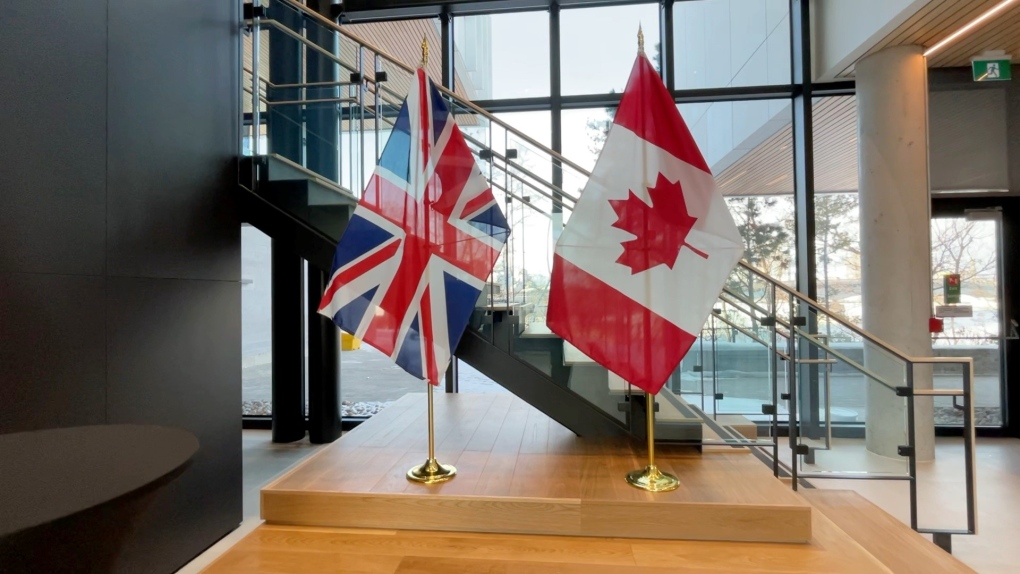Here's a look inside Ottawa's newest diplomatic building
The British High Commission has relocated to a new office on Sussex Drive.
- Sign up now for our nightly CTV News Ottawa newsletter
- The information you need to know, sent directly to you: Download the CTV News App
CTV News Ottawa was one of the first to tour the building, hosted by British High Commissioner to Canada Susannah Goshko.
Staff said goodbye to the previous offices at 80 Elgin Street, which was sold to the National Capital Commission (NCC).
"That building had about nine floors. It’s from a time where we had whole teams of people doing visas and passports. Those sorts of things are done electronically now and we just don’t need that kind of space," said Goshko.
The state-of-the-art building is located within the Earnscliffe National Historic Site, which has been the official residence for British high commissioners for more than 90 years.
The building was officially opened at a ceremony held on Jan. 12.
Goshko was joined by Claudette Commanda, an Algonquin Anishinaabe Elder from the Kitigan Zibi Anishinabeg First Nation, who performed a blessing ceremony to officially open the new office.
 The Canadian and United Kingdom flags inside the new British High Commission. (Peter Szperling/CTV News Ottawa)The new offices boast an open layout with lots of light.
The Canadian and United Kingdom flags inside the new British High Commission. (Peter Szperling/CTV News Ottawa)The new offices boast an open layout with lots of light.
"We're really thinking about how the modern diplomatic mission works and designed it to deliver that function," she said.
The building also has a focus on the environment.
The building is targeting LEED Gold Status (Leadership in Energy and Environmental Design) certification — a widely used green building rating system.
"It is the greenest building in the whole of the Brits' diplomatic network," said Goshko.
According to a press release, green credentials of the new building include diverting 98 per cent of construction waste away from landfills and incorporating wood salvaged from the Ottawa River.
The office aims to be economically sustainable by operating at a lower cost, thanks to its energy efficiency rating currently on track to perform at 18 per cent above the baseline average.
Water consumption will also be reduced thanks to environmental features being incorporated into the landscape design, including native and drought resistant vegetation that mitigates the need for irrigation.
Low flow plumbing fixtures throughout the building also aim to reduce annual water consumption by between 25 to 30 per cent above the baseline average.
CTVNews.ca Top Stories

Trudeau promoting backbenchers in sizable cabinet shuffle coming Friday: sources
Prime Minister Justin Trudeau is planning a sizable cabinet shuffle on Friday, and it's shaping up to see several Liberal backbenchers promoted to ministerial posts, sources confirm to CTV News.
Prime minister's team blindsided by Freeland's resignation: source
The first time anyone in the senior ranks of Prime Minister Justin Trudeau's office got any indication Chrystia Freeland was about to resign from cabinet was just two hours before she made the announcement on social media, a senior government source tells CTV News.
'Tragic and sudden loss': Toronto police ID officer who died after suspected medical episode while on duty
A police officer who died after having a suspected medical episode on duty was executing a search warrant in connection with an ongoing robbery investigation in North York, Toronto police confirmed Thursday.
Ontario town seeks judicial review after being fined $15K for refusing to observe Pride Month
An Ontario community fined $15,000 for not celebrating Pride Month is asking a judge to review the decision.
The Royal Family unveils new Christmas cards with heartwarming family photos
The Royal Family is spreading holiday cheer with newly released Christmas cards.
EXCLUSIVE Canada's immigration laws 'too lax,' Trump's border czar says
Amid a potential tariff threat that is one month away, U.S. president-elect Donald Trump's border czar Tom Homan is calling talks with Canada over border security 'positive' but says he is still waiting to hear details.
Who received the longest jail terms in the Gisele Pelicot rape trial?
A French court found all 51 defendants guilty on Thursday in a mass rape case including Dominique Pelicot, who repeatedly drugged his then wife, Gisele, and allowed dozens of strangers into the family home to rape her.
Crowd crush kills 35 children at funfair in Nigeria, police say
At least 35 children were killed and six others critically injured in a crowd crush at a funfair in southwest Nigeria on Wednesday, police said.
Scientists think they know why Stonehenge was rebuilt thousands of years ago
Scientists made a major discovery this year linked to Stonehenge — one of humanity’s biggest mysteries — and the revelations keep coming.


































